
Carpathian Wooden Churches are religious structures made of wood and built in the Vernacular architecture of the Carpathians. These occur in the following areas:

Carpathian Wooden Churches are religious structures made of wood and built in the Vernacular architecture of the Carpathians. These occur in the following areas:

The wooden churches of Maramureș in the Maramureș region of northern Transylvania are a group of almost one hundred Orthodox churches, and occasionally Greek-Catholic ones, of different architectural solutions from different periods and areas. The Maramureș churches are high timber constructions with characteristic tall, slim bell towers at the western end of the building. They are a particular vernacular expression of the cultural landscape of this mountainous area of northern Romania.

Lemkos are an ethnic group inhabiting the Lemko Region of Carpathian Rus', an ethnographic region in the Carpathian Mountains and foothills spanning Ukraine, Slovakia and Poland.
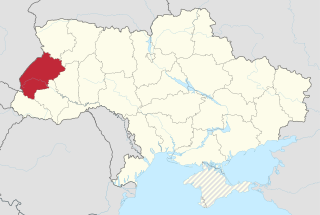
Lviv Oblast, also referred to as Lvivshchyna is an oblast (province) in western Ukraine. The administrative center of the oblast is the city of Lviv. The current population is 2,497,750.

The Boykos, or simply Highlanders, are an ethnolinguistic group located in the Carpathian Mountains of Ukraine, Slovakia, Hungary, and Poland. Along with the neighboring Lemkos and Hutsuls, the Boykos are a sub-group of Ukrainians and speak a dialect of Ukrainian language. Within Ukraine and according to majority of linguists, the Boykos and other Rusyns are seen as a sub-group of ethnic Ukrainians, and the Rusyn lect is regarded as part of a dialect continuum within Ukrainian. Boykos differ from their neighbors in dialect, dress, folk architecture, and customs.

The Beskids or Beskid Mountains are a series of mountain ranges in the Carpathians, stretching from the Czech Republic in the west along the border of Poland with Slovakia up to Ukraine in the east.

Stryi is a city located on the left bank of the river Stryi in Lviv Oblast (region) of western Ukraine 65 km to the south of Lviv. It serves as the administrative center of Stryi Raion (district). Stryi hosts the administration of Stryi urban hromada, one of the hromadas of Ukraine. Its population is approximately 59,608 .
Wooden church may refer to:
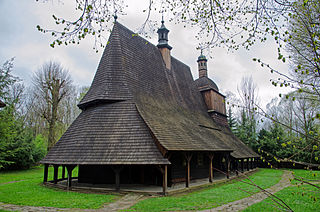
The wooden churches of southern Lesser Poland of the UNESCO inscription are located in Binarowa, Blizne, Dębno, Haczów, Lipnica Murowana, and Sękowa. There are in fact many others of the region which fit the description: "The wooden churches of southern Little Poland represent outstanding examples of the different aspects of medieval church-building traditions in Roman Catholic culture. Built using the horizontal log technique, common in eastern and northern Europe since the Middle Ages..."

Skole is a town in Stryi Raion, Lviv Oblast (region) of Ukraine. It hosts the administration of Skole urban hromada, one of the hromadas of Ukraine. Population: 6,104 .

Poloniny National Park is a national park in northeastern Slovakia at the Polish and Ukrainian borders, in the Bukovské vrchy mountain range, which belongs to the Eastern Carpathians. It was created on 1 October 1997 with a protected area of 298.05 km2 (115.08 sq mi) and a buffer zone of 109.73 km2 (42.37 sq mi). Selected areas of the park are included into Primeval Beech Forests of the Carpathians UNESCO World Heritage Site.

The vernacular architecture of the Carpathians draws on environmental and cultural sources to create unique designs.

Carpathian Wooden Churches is the name of a UNESCO World Heritage Site that consists of nine wooden religious buildings constructed between the 16th and 18th centuries in eight different locations in Slovakia. They include two Roman Catholic, three Protestant and three Greek Catholic churches plus one belfry in Hronsek. In addition to these churches there are about 50 more wooden churches in the territory of present-day Slovakia mainly in the northern and eastern part of the Prešov Region.
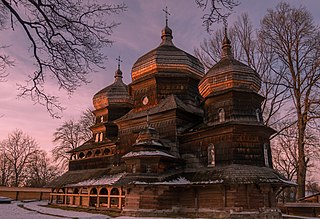
St. George's Church in Drohobych is one of the oldest and best preserved timber churches of Galicia. The church is a monument of Galician wooden architecture of the late 15th - early 16th centuries, one of the best preserved and one of the best monuments of ancient Ukrainian sacral architecture. Built in the 15th century, it has been rebuilt several times and given the final architectural forms by the talented Ukrainian architect Hryhoriy Tesla from Drohobych. The church is part of the wooden architecture department of the Museum of Drohobych region.

St. Nicholas's Church is the centerpiece of the Lviv Museum of Folk Architecture and Culture, better known as Shevchenkivskyi Hay. It is also part of the Lavra of Saint John of the Ukrainian Studite Monks. This traditional tripartite timber church, encircled by a wooden fence, was transferred in 1930 to Lviv from Kryvka village, now in Sambir Raion, Lviv Oblast. It was originally built by Boiko carpenters in 1763. During the First World War the church was damaged by a shell that pierced the upper gallery.

Wooden church architecture in Ukraine dates from the beginning of Christianity in the area and comprises a set of unique styles and forms specific to many sub-regions of the country. As a form of vernacular culture, construction of the churches in specific styles is passed on to subsequent generations. The architectural styles vary from very simple to complicated, involving a high degree of carpentry and wood-cutting artistry.

The Wooden Tserkvas of the Carpathian Region in Poland and Ukraine are a group of wooden Orthodox churches located in Poland and Ukraine which were inscribed in 2013 on the UNESCO World Heritage List which explains:
built of horizontal wooden logs between the 16th and 19th centuries by communities of Orthodox and Greek Catholic faiths. The tserkvas bear testimony to a distinct building tradition rooted in Orthodox ecclesiastic design interwoven with elements of local tradition, and symbolic references to their communities’ cosmogony. — World Heritage Centre
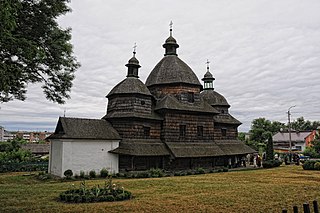
Wooden Holy Trinity Church was built in suburb of Zhovkva, Ukraine in 1720 on the place of a church that burned down in 1717. The structure consists of three wooden naves and a brick sacristy.

St. Michael Church was built in suburb of Uzhok, Ukraine in 1745. The structure consists of three wooden naves and a brick sacristy.
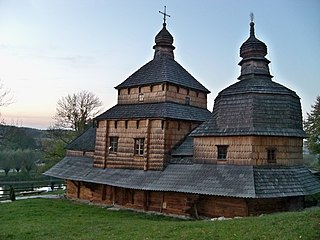
Wooden Descent of the Holy Spirit Church was built in suburb of Potelych, Ukraine in 1502 on the place of a church that was burned down by tatars. It is the oldest wooden church in Lviv Oblast. Church was visited by Bohdan Khmelnytsky